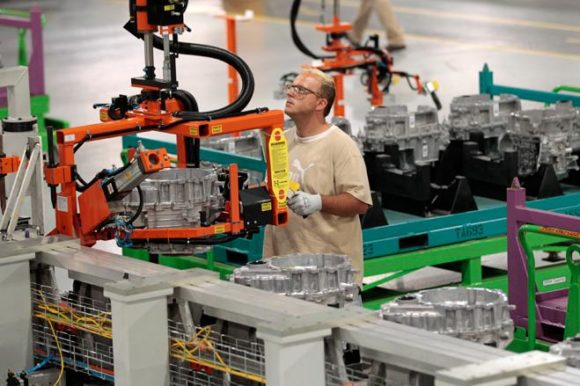
By David Chavern
As we celebrate National Manufacturing Day, what is the current state of the industry and what do we need to do to bolster it?
It’s important to first debunk the popular misconception that U.S. manufacturing is in decline. In fact, U.S. manufacturing output (on a value-added basis—meaning the value of finished products and not double-counting component parts) actually rose by 73% between 1993 and 2011, according to the U.S. Department of Commerce. U.S. manufacturing produces $1.7 trillion of value each year—or 11.7% of GDP. According to the National Association of Manufacturers, for every $1 spent in manufacturing, another $1.35 is added to the economy.
Another fact is that the United States remains the world’s largest manufacturer, accounting for 24% of world manufacturing value added in 2010—a share greater than that of China (15%), India (2%), Brazil (1.7%), and Russia (1%) combined—according to the United Nations Industrial Development Organization(UNIDO). The U.S. share of world manufacturing output, on a value-added basis, has remained fairly steady for about four decades.
It’s also true that American manufacturers were hit hard by the great recession and suffered a steep fall in demand. But throughout the two decades leading up to the recession, U.S. manufacturers set new records for output, revenues, profits, and return on investment. So we’re still operating from a strong foundation.
What do we need to do to continue the positive trend and drive stronger growth in the manufacturing sector?
For starters, we need to come to terms with the shift in the industrial labor market. Though profits and output have surged, the same can’t be said of factory jobs. U.S. manufacturing jobs peaked at 19.5 million in 1979. But by 2010, the number of Americans employed in manufacturing fell to a new low of 11.4 million.
Where have the lost manufacturing jobs gone? Not to Mexico or China. Survey data consistently show that less than 1% of layoffs can be attributed to offshoring. In reality, most of these jobs have been lost to a country called “productivity.” Technological change, automation, and widespread use of information technologies have enabled firms to boost output even as some have cut payrolls. According to the Wall Street Journal, “rapid technological advances are making sophisticated capital goods cheap substitutes for low-skilled workers.”
From an operational standpoint, these efficiency gains are a boon to business. But they’ve also dramatically transformed the labor market and fundamentally altered the concept of a “good manufacturing job” in America. For earlier generations, workers without advanced skills or postsecondary education could make a good, stable living with a factory job. Today, the opportunities for unskilled workers are diminishing. Factory jobs are fewer and farther between, and many require advanced skills to run computers and automation systems. Consequently, labor shortages are a growing challenge for manufacturers. This is yet another sector being hit by the widening skills gap in America—and we must intensify our work to bridge that gap so manufacturing can continue to thrive and more Americans can be matched with today’s good jobs.
We must also ensure we have access to open markets. It’s not enough for us to keep making things in America—we’ve got to sell them around the world. To support the continued expansion of manufacturing, exports are more important than ever. U.S. exports of manufactured goods topped $1.2 trillion in 2011. Meanwhile, total U.S. manufacturing value added surpassed $1.8 trillion. In fact, exports generate revenue of more than $100,000 for each American factory worker, according to the U.S. Bureau of Labor Statistics and U.S. Department of Commerce. Compare this with the annual mean wage of the typical U.S. manufacturing worker—$46,600. There is no way manufacturers could make their payrolls without the revenues they earn by exporting.
Finally, we need to keep America the best place in the world to do business. In addition to addressing that skills gap and boosting exports, we must restructure our uncompetitive tax code. We’ve got to restore common sense to our legal and regulatory systems. And we must make sure that manufacturers have access to affordable, reliable energy supplies.
Today, let’s not just celebrate National Manufacturing Day—let’s reaffirm our commitment to making things in America. And let’s give this critical sector the right policy environment to keep America’s great manufacturing engine humming.
